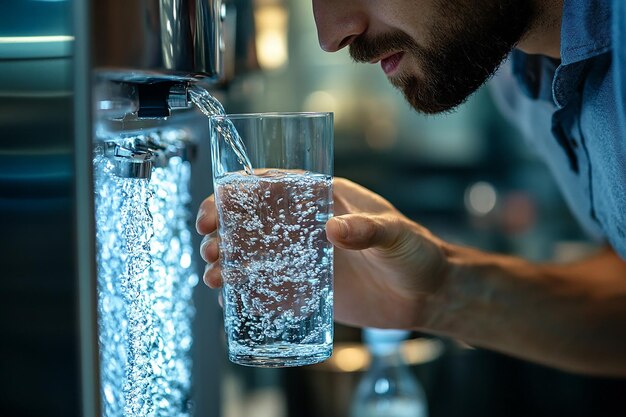Choosing the Right Water Filter for Your Samsung Refrigerator: A Complete Guide
Ensuring that your refrigerator provides clean, fresh-tasting water is a priority for many households. This usually involves knowing the right water filter to use. If you're a Samsung refrigerator owner, understanding which filter you need isn't just a question of compatibility—it's about convenience, efficiency, and safety. Let’s dive into everything you need to know to make an informed choice.
Understanding Samsung Water Filters
Why Are Water Filters Important?
Water filters are essential for removing impurities like chlorine, lead, and other contaminants that may be present in tap water. These filters not only improve water taste and odor but also ensure that what you're consuming is healthier.
Samsung Refrigerator Water Filter Types
Samsung offers various types of water filters tailored to its range of refrigerators. Each is designed to fit specific models and comes with different features to address various water filtration needs.
HAF-CIN/EXP (DA29-00020B) - This is one of the most common water filters for Samsung refrigerators. Designed to remove over 99% of harmful contaminants like chlorine, lead, and asbestos, it's typically used in French door and side-by-side refrigerator models.
HAF-QIN/EXP (DA97-17376B) - This filter is known for its slim design, often used in refrigerators with limited space. It's effective against many impurities while maintaining a high flow rate.
HAF-CU1/EXP (DA29-00003G) - Ideal for older Samsung refrigerator models, this filter effectively removes chlorine taste and odor along with other potential contaminants.
How to Identify the Right Filter for Your Samsung Refrigerator
Model Number Check
To determine which filter your refrigerator needs, start by checking the model number of your refrigerator. This can usually be found on a label inside the fridge, often in one of the door jams or near the drawers.
Existing Filter Examination
If you already have a filter installed, remove it (after shutting off the water supply) and check its model number. This can often be the easiest way to determine which filter you require.
Samsung Website and Manuals
Samsung’s website offers a user-friendly way to find compatible parts for your model. Additionally, the refrigerator’s user manual will list suitable filters for your specific appliance.
Installation and Maintenance Tips
Installing Your New Filter
Turn Off the Water Supply: Safety first — always turn off the water supply to the refrigerator before changing the filter.
Old Filter Removal: Rotate the existing filter counterclockwise to release it. Certain models might require you to pull the filter straight out without twisting.
Insert the New Filter: Align the new filter, push it into the slot, and rotate it clockwise until it clicks into place. Ensure it’s securely fitted to prevent leaks.
Flush the New Filter: Run several glasses of water through the dispenser to remove any air and small carbon particles. This is crucial for ensuring clean water thereafter.
Frequency of Replacement
Typically, Samsung recommends replacing the water filter every six months. However, this can vary based on your water quality and usage. Some modern Samsung refrigerators have an indicator light to notify you when it’s time for a change.
Benefits of Regular Replacement
Replacing your water filter regularly ensures efficient filtration, maintains water quality, and prevents build-up that could damage the filtering mechanism.
Related Subtopics to Enhance Your Understanding
Alternative Filtration Systems
For those looking beyond typical refrigerator filters, other filtration systems include:
Whole-House Water Filters: These are installed in your home's main water line, filtering water for all sources.
Under-Sink Filters: Installed directly under kitchen sinks, they offer a thorough filtration system without the need to replace refrigerator filters frequently.
Environmental Impact and Sustainability
Using recyclable or reusable filters can lessen the environmental impact. Many brands offer programs to recycle old filters properly, so consider this option to contribute positively to the environment.
Cost Considerations
While buying brand-specific filters ensures perfect compatibility, they may be more expensive. Third-party filters that fit Samsung refrigerators might be cheaper, but always verify compatibility and certification before purchase.
Troubleshooting Tips for Water Filter Issues
Here are some common concerns and what you can do about them:
Reduced Water Flow: If the water flow from your refrigerator decreases, check for a clogged filter or an incorrectly installed filter.
Bad Tasting Water: This could indicate a filter that needs replacing. Also, check that the filter is installed correctly without any blocking debris.
Leaks: Ensure the filter is tightly secured and the housing is not cracked or damaged. Always verify installation steps in the refrigerator’s user manual.
Quick Reference Summary: Your Go-To Guide for Samsung Water Filters
🔹 Determine Your Filter Type:
- Identify your refrigerator model number through the appliance or its manual.
- Match the model to the recommended Samsung filter.
🔹 Installation Tips:
- Turn off the water supply before any changes.
- Rotate the old filter counterclockwise; install the new one by screwing clockwise.
- Flush out the new filter with water to start.
🔹 Replacement Frequency:
- Change filters approximately every six months, depending on usage.
🔹 Additional Insights:
- Consider full-house or sink systems for comprehensive water filtration.
- Opt for recycling programs for used filters to reduce environmental impact.
🔹 Common Issues & Solutions:
- Reduced Flow: Check for clogging.
- Taste Problems: Ensure timely replacements.
- Leaks: Check installation and filter integrity.
Maintaining the quality of water from your Samsung refrigerator is a straightforward task with the proper knowledge and equipment. By choosing the right filter and keeping up with regular maintenance, you can enjoy fresh-tasting, safe water at home every day.
